LCD Digital Circuit Tester
Thank you! Your comment has been submitted successfully. You should be able to view your question/comment here within a few days.
Error submitting comment. Please try again momentarily.
- All Info
- Reviews (26)
- Q & A (0)
- Videos (2)
- Photos
Performance Tool Electrical Tools - PTW2992
- Testers
- Circuit Tester
- Performance Tool
Features:
- Economy LCD Circuit Tester with LED back light
- Ideally used to detect power, voltage, ground, and circuit integrity
- Surge protected circuitry displays DC voltage from 3V to 48V (±0.3V accuracy)
- Conduct circuit tests with increased accuracy and ease
- LED indicates RED for power or GREEN for ground
W2992 Performance Tool LCD Digital Circuit Tester
W2992 LCD Digital Circuit Tester
California residents: click here


Videos are provided as a guide only. Refer to manufacturer installation instructions and specs for complete information.
Video Transcript for Feature Breakdown: LCD Digital Circuit Tester
Hi, they're hard workers! Today we're going to be taking a look at Performance Tool's LCD circuit tester. To give you an idea of how your circuit tester works, it has LEDs in here that'll light up when both power and ground is present. You'll have to clip your probe onto either power or ground. The, the clip end here, we've got that attached to the ground side of our battery. And then with the probe end, instead of the clip side, you'll touch this to your other circuit. And if there is the opposite there it'll light up.
So currently you've got ground on the clip side and our probe, or touching on the positive of our battery post and it lights up red. It also gives us a voltage reading on there, raking in about 12 and a half volts. Now we could swap this and hook it up the other direction. So we're hooking our clip onto positive, and then we're going to take our probe and touch it to ground, and it also lights up. But you will notice now that it's lit up green, letting you know that your probe side is touching on ground and you have power present on your clip side.
You'll also get a voltage reading there. And that's really nice that you get a voltage reading there, because if you have any drop across your circuit, you can help detect that as well. So you can kind of check out the integrity of your circuit while doing this. It's kind of a special thing here. Most of your test lights will just have a light on it.
It's really nice. And you've got that volt meter on there as well to get additional information. For example, currently now we're reading about 12 and a half volts, but if I was checking this further on down the circuit, and if we had some corrosion in that circuit, I may only read 12.1 volts further on down that circuit. And I know, Hey, the voltage has dropped from what it is here at the battery by a few tenths of a volt down there. Maybe I should look for a little bit of corrosion or a bad connection at that point.
And it may even drop even lower. You may only have like 10 or 11 volts and if you're checking it like that, then there's a good chance that you're finding, Hey, this is probably why I'm finding where my issue is. My item wasn't working. I was checking my circuits along the way, and I see a drop in voltage that's excessive, check your circuits there. So we're gonna go ahead and go through some examples of common uses of this and some, little bit more in depth tests that you can perform with a test light. Often people will use these to test the circuits at the back of their vehicle, and they usually do this when they plug up to your trailer and you find like, Hey, I don't have taillights or I'm missing a turn signal or something like that. Well, rather than immediately digging in and trying to fix some wires, let's figure out, Hey, where's the issue at is the issue on my vehicle side or is the issue with my trailer. That's where I like to start. So I've gone ahead and turned on the hazard lights in the vehicle, as well as the tail lights. And that should activate all of our signals. So we're going to take the clip here. We're gonna hook this on ground, which is the exposed stud there, so just flipping that on there, kind of putting the rubber boot off to the side here a little bit to help keep me from touching it. And now we're just gonna check our circuits. So here, we've got 12 volts here at the back. So we know that our taillight circuits working, and we've got a flashing signal there giving us our 12 volts so we know that that's working. And if we look at here, the color of the wire coming in, that's yellow, so that's gonna be our left turn signal. And then our right turn signal is the green wire. When we checked this one as well, we'd get our light lighting up and giving us our 12 volts. So we know that our vehicle side here is working properly. And this will also work when testing your six and seven way connectors as well. You just need to pay attention to what the circuits are. So for the four-pole ones, we we're able to turn on tail lights and hazards to get all these operational. With a seven way, you'll need a brake controller plugged in and somebody operating the output of it in order to be able to test that circuit, your auxiliary circuit should normally just have power on it all the time, but sometimes you have to start the vehicle to get the auxiliary circuit to come on. So just pay attention to those. So that way you know that you're getting the output back to your connector when you're checking, just verify that your vehicle has that particular output. In this instance, if we had an issue with our trailer though, we know that our vehicle's okay, so we can go ahead and button up this side. We don't need to diagnose anything over here. We would then turn to our trailer and try to figure out, okay, why, why is that signal not working So then we would do that from there. So here, we've got a scenario for you where we're going to show you a short to ground and how to diagnose it. Currently, I've got a scenario set up, so our board here, this is the load for our device. It's going off right now. And this just normally comes on when you put your vehicle in reverse. So let's say in our scenario, we put our vehicle in reverse, but instead of this, coming on, nothing happened because this was what a short to ground would be like, if there was a bare spot on your wire, it would spark a little bit. And what would eventually happen, it was over, it would overload the circuit and then it would pop your fuse. And if we take a look here, we can see that the fuse has blown. It's now open. So this was a temporary thing that we just put in there in place. But if you've got a short to ground in your trailer, it's likely always gonna be grounded out like that. So let's just go ahead and set that scenario up. So now we're in the current faulted state where we had started where the board was working, was the proper fixed state. We simulated a short to ground. So we're just gonna put this short to ground back so I'm stuffing that there. I'm just stuffing this in here just for simulation purposes. So now what's going to happen next is you go, oh, I got a blown fuse. Okay. Well, my fuse is blown. I'll just put another fuse in. And when you go to put another fuse in, you got to pull it back into reverse or operate, whatever accessory you're planning on operating, and it just pops the fuse again. Oh no. Well now, you know, you've got a real problem you gotta solve. Your test light can be a real wonder in these scenarios cause we can take that fuse out of there, Instead of wasting a bunch of fuses, what we can do is we can complete the circuit with our test light. And normally when you're doing this, you're probably gonna have to take a, a paper clip or something like that to clip into the other ends. And you can poke it down in there. So I'm gonna grab one of those real quick so we can mock that up. So now what we've done is we've taken our test light and we put it in place where the fuse used to be. The probe is in one prong, and then we used a paper clip and clipped it onto the clip side of the other side of the test light and put that in the other prong. And what you'll see there is that our test light has lit up. So what you'll want to check now is where, we know that this light's only gonna light up. if we've got a complete circuit that has a path all the way from power, all the way to ground, and then it'll light that light. So at this point you can put it in the particular state in which you're trying to activate, whatever it be, a light or whatever you're putting it in reverse to activate a light, go ahead and do that. We can see that's lit up. And now you would just start disconnecting circuits until you figured out an isolated where the short was. One of the things I like to do first, if it's easy to get to, is to take away the ground at the very end of the circuit, because our test light doesn't take very much current to amp, to light up. So if you think it's like a bulb or something, it can actually go through the bulb, so let's make sure that particularly at the ground at the very end of the circuit, So this is the load at the end. This is normally like a brake light bulb or something. You have your power that goes to the bulb or whatever your load is, and then the other side just goes right to ground. Well, if we remove this ground here at the end, what should happen is your test lights should turn out if there's no shorts, but if you look here, our test light's still lit up. That means that there's a path to ground still somewhere present. So you would work your way down the line to the next easiest connection point that you get to, and you would disconnect it there. If the test light turns off, then you know, okay, my short is between the point that I just disconnected there, and then a point further towards the back of the vehicle, back closer to the battery. If you just keep disconnecting circuits and the lights still light up, it is still lit up, then you know that you need to keep working your way towards the battery to find that issue. After I disconnect the one at the very back, what I usually do next is I'll disconnect the one here at the very front, and that way, I've eliminated between those two connectors and I can start finding that point. So we know our short to ground's here cause We did it here in this particular test scenario. But if we see if we disconnect this circuit there, we have no more test light turned on, cause it's no longer shorted to ground. So that can be a really useful test item to find short to ground without popping a bunch of fuses. Cause if you want to get power in the circuit to check for power, each time you'd have to put that fuse in there. And it probably end up blowing that fuse because of the current state it was in. But we can use our test light to get current through there and check it. Next we're going to show you guys how to perform a voltage drop test. And this is one of my favorite tests for finding difficult issues that can arise with circuits. Cause you could have a circuit that's completed, but still has high resistance or issues with it that can cause strange conditions to occur. So first thing we want to do is we're going to be using the volt meter portion of our test light now to do these tests. So whenever you're doing a voltage drop test, the first thing you want to do as a baseline test. We want to see what the voltage is at the battery. So we've got 12.4 volts right at our battery. We've got this lead on negative than on positive 12.4. We're going to use our test circuit once again. And I want to show you guys something neat. The circuit's complete, all that it needs ground to hook on, and then I'll turn on our board. This board does have a delay in it before it begins to activate the beeping. So we are going to get a little bit of time before it's going to go off on us there. But I wanted to show you guys that while we had 12 volts here at the battery, we check here at the ground connection where it's not disconnect, where it's not connected to ground. It's currently disconnected. Look at this guys. You got about 3.1 Volts there. So we still have some voltage that is present there. And in most cases, you're going to read very close to battery voltage here, unless the resistance gets too high. If we go ahead and clip this on ground, whenever you're checking like a light bulb or any kind of circuit, when you're checking your voltage drop, that can tell you the conditions of your circuit. So we're gonna complete the circuit by clipping this on. That'll complete our circuit here. So now if we check, this is on the ground side here, nothing. It doesn't even light up at all. Because all of our voltage should drop across our load. It should drop completely across here. If you still have voltage present on the other side, that typically indicates that you have a poor connection in here somewhere. I'm gonna go ahead and disconnect it to turn that off. But that usually indicates you've got a poor connection somewhere in here, because there was still some voltage present on the other side of your load. That means that there's corrosion or a bad connection. Maybe you got like two wires are barely touching here. That poor connection there, that high resistance, is actually consuming some of that voltage in order for it to get across that, to get to ground. And that can cause your lights to light up very dimly. If it's a computer module, sometimes it can cause it to wig out to where it does very unexpected things. So by doing your voltage drop test, that's one of my favorite ones to be able to narrow down those issues. And we're going to just run down this circuit here. So we're now at the battery, when we clip on here, we had about 12, four, and it's normal over the length of wire to see about a 10th of a volt drop. So we've got it right here at the battery, 12 three, we're gonna go right just the other side of our circuit protection. And we're right at about 12, 4, 12, 3. We haven't dropped any voltage yet. And then we heard up here to our tester but we can't quite get in there. 12 four still good there. And then we go right onto the other side here while it's activating and we get absolutely nothing. It's completely dropped across the circuit. You always want to see that. If you see something like, maybe you see like 10.4, more than likely, this thing's probably just dropping a little bit of voltage. You've actually really got a major issue on here on the ground side. The more voltage you have on the ground side of the circuit, past the load, the more issue, you know, you've got right here. The other thing we we're checking when we we're checking voltage drop there, we saw that it was nearly 12 four all the way up to our load. Let's say right here at the load, at the light bulb of whatever your load is, you're only measuring maybe like six volts. And of course your lights probably not gonna work, whatever here's probably not working properly. You know, between this point here and the battery up here, you had six volts that has dropped across that circuit. So you need to check the wiring between this point and that point to figure out why that voltage dropped. And again, it's typically going to be caused by a poor connection or heavy corrosion in that circuit. And that completes our look at Performance Tool's LCD circuit tester..
Customer Satisfaction Score:
99% were satisfied with this product
1% of customers were not satisfied
Ratings & Reviews
4.8
26 reviews

Used it twice it fried would not recommend. I bought the tester for general trailer repair for testing lighting circuits and all around diagnostics the one time that it did work it was nice to see the voltages but I just went back to my regular test light. Nothing like having a tool in your box that is garbage and not dependable. Buyer beware.
This is an awesome product at a great price. Elsewhere online it was $100 so it was a large savings You can check ground just like a regular
trouble light but it light up green and you know how strong your ground is.Then you can check power supply then it lights red for power and lets you know the volts. I have tested my remote battery to find out it was weak it was below 3 new one tested 3.1 .I work in the auto field so it will be used to check batteries, charging systems, light sockets,window switches, ect. I love this tester I wont have to break out my ohm meter near as much.The tester appears to be very well built time will tell.For around $20 everyone should own one.
These guys make that online big box store look like a minor league player. The shipping was fast, the product is great and works well. I will be ordering two more this week as everyone who borrowed mine loved the product. I already sold one to co-workers diagnosing electrical problems. The 48 volt capability makes this one tool capable of diagnosing weak batteries in parrallel and series wiring, measuring solar panel output, and diagnosing voltage draw a breeze.
Excellent product. Just what is needed for all the new electronics systems. Computer safe, test circuits without fear of damaging equipment. The addition of the digital voltage readout is a big plus when testing and trouble shooting. Bought two, will order a third for the boat emergency tool kit. Invaluable tool for those pesky electrical gremlins.

A very convenient tool. Easy to use.

Great product at a great price. It sure came in handy. Thank You.

Bauers H.

4/2/2022
Were a shop that specializes in hitch installs and this absolutely helps a ton in diagnosing wiring and testing for shorts in trailer wiring, the volt meter is unique to this brand and we have nearly 7 on hand because of that.
I received the item way earlier then expected and it works exactly as said and exactly as I need it to. Very high quality great for quick electronic diagnosis.

Works great
Great product work well
great item, fast delivery, just what I ordered. Thank You
good product at affordable price,
Great product and excellent service

See what our Experts say about this Performance Tool Electrical Tools
- Troubleshooting Prodigy P3 that Doesnt Turn OnAre you using the # 3041-P adapter? It's the correct one for your 2018 Toyota 4Runner. Test the connector under the 4Runner's dashboard with a circuit tester, like part #PTW2992, to test for power. If there's no power start by checking the fuses. If there's power at the plug reconnect the harness to the vehicle and test the pins on the other side of the harness. Check the pins at all the connectors and make sure none are bent. They're fairly thin so they get bent pretty easily. They...
view full answer... - How to Find COLD Side of Brake Light Switch for Hardwiring Brake ControllerWhen you are hardwiring a trailer brake controller like the Prodigy P2 # 90885 the red wire connection that provides the triggering signal to the controller should be made to the wire on the COLD SIDE of the brake light switch circuit. This is the wire that carries 12V power ONLY when you press the brake pedal and at no other time. Please refer to the linked photo and article for more details. If you were to connect the Prodigy to the HOT side wire then the controller would constantly...
view full answer... - Troubleshooting Furrion RV Tankless Water Heater Wall Controller Not Powering OnYou will want to check for power going into your Wall Controller # FR48NR by removing it from the wall and testing the wires with a Circuit Tester # PTW2992 that shows you battery voltage or by using a Multimeter # PT89ZR. Both wires will be blue and polarity doesn't matter you just need to identify if you are getting 12 volts of power to the controller and have a good ground. Be sure that the power switch on the outside portion of the water heater is switched on. If you have power at the...
view full answer... - Which Pin On A 7-Way Should Have Constant 12V Power When Vehicle Is RunningThe only pin that should be continuously showing 12V power on the 7-Way connector on your vehicle is the 12V power circuit which is normally the black wire but not always. In 7-way wiring the 12V auxiliary power feed is carried on the contact at the 1:00 position as you look at the socket. I have added a photo that shows you the pin positions. I recommend to use a circuit tester like part # PTW2992 to test the pins on your 7-way for power. If the brake output is the one with constant power...
view full answer... - Red Light on Hayes Brake Controller Stays on and Drains Tow Vehicle BatteryI am not sure which Hayes brake controller that you have, but in reviewing the installation instructions for the Hayes-Lemmerz Energize III+ Electric Trailer Brake Controller # HA81742B I found that there is a section that goes over if the "Controller red indicator on all the time." The solutions they offer call for testing the Red wire and the Blue wire on the brake controller with a circuit tester like part # PTW2992. The Red wire connects to your Stop Light Switch and only receives...
view full answer... - Installing a Trailer Wiring Converter on 1998 Dump TruckYou'll need to use a circuit tester like # PTW2992 and test each pin on your 7-way as its function is activated. The pin in the 3:00 position should light up when the right turn signal and when the brake pedal is activated. The pin in the 9:00 position should light up with the left turn signal and brake pedal. I'm guessing when you test, you're not going to get brake signal at those two pins which means that the signal you're getting is unconverted. To fix things, you'll need to install...
view full answer... - Troubleshooting No Power At The Factory Trailer PlugThere are a few troubleshooting steps to help you figure out why you have no power. I would start by making sure that there is not any corrosion or debris blocking your connection points. If they are clean or still no power after cleaning, I would check your grounding connections. Make sure your grounds are firmly connected to a clean, bare metal surface. Next, test the pins on the connector where the wiring harness plugs into the truck using a circuit tester like Item # PTW2992....
view full answer... - How to Replace a 4-Wire Clearance Light with a 2-Wire Clearance LightSince both of the green wires are right next to each other and both of the white wires are next to each other I think that's how your running light and ground circuits are linked to the next light. So you could cap off a green and a white wire (electrical tape isn't as safe) when you install your clearance light like part # MCL32ABB but I think that would break the chain and all of the lights on the back of these circuits wouldn't work. The best way to test this out is to simply disconnect...
view full answer... - Troubleshooting Right Brake Light on Trailer Not Working But Right Turn Signal is WorkingThank you for all of the details in your question. It looks like you have a faulty ground or some corrosion in one of your connectors. On a trailer the functions for your turn signals are also tied into the brake lights so if your right turn signal is working on your trailer but the brake light isn't then there are a few things you can do. I recommend starting off by checking both the connector on your 1998 GMC Savana and the connector on your trailer. Check to make sure that they are...
view full answer... - Where to Connect Brake Controller Adapter in on a 2014 Toyota Tacoma with Factory 7-WayIf your 2014 Toyota Tacoma came with the Factory 7-Way then you will want to look next to the driver side kick panel for the wiring harness. I have attached a video of the Tekonsha P2 # 90885 being installed on a 2012 Tacoma that you can reference. This installation video shows the Plug-In Wiring Adapter # 3040-P being installed for the P2 which will be the same as Curt Adapter # C51362 for your Curt brake controller. If your connector is not located there then let me know and I can...
view full answer... - What Color Wire Typically Carries the Running Light Circuit Hey Bill, based on traditional trailer wiring colors the brown/black wire would be the correct circuit to use for running lights but I would recommend using a circuit tester like part # PTW2992 to test this circuit for voltage when the running lights are on.
view full answer... - Troubleshooting No Signal on Monitor for Furrion Camera FOS43TASF on Apline TrailerThe first thing you'll want to check with your camera system is that power is reaching both the camera and the monitor parts. Cameras like the one in Furrion system # FOS43TASF can be wired either to a reverse light circuit (to operate as a backup camera) or to the running light circuit (to operate as an observation camera). My contact at Furrion said that both camera systems, # FOS43TASF and FOS48TABL, should be compatible with your trailer's pre-wiring. If you have another 12V device...
view full answer... - Troubleshooting Light Bar That Only Functions In The Accessory Ignition Position It sounds to me like the light bar was wired to the running lights which is why it works with your truck's ignition in the accessory position but cuts off when you start the engine. You can test this by checking the wire functions with a circuit tester like # PTW2992. Or simply turn your headlights on in your 2018 Ford F-350 Super Duty and check if the light bar is working. If this is not the case let me know and we can keep troubleshooting further.
view full answer... - Troubleshooting No Power to iRV Stereo 35 on 2019 Rockwood Windjammer 3008VThe first thing to check is to make sure that your iRV RV Stereo # 292-101809 is actually getting power. Even if the fuse looks good there may be a problem with the wiring somewhere which is causing the issue you are seeing. Try taking a circuit tester like part # PTW2992 and testing the yellow power wire that has the 15A fuse on it. Test the wire before the fuse to see if power is getting to the fuse. If there is power to the fuse then test the wire after the fuse. If there is power still...
view full answer... - Trailer Light Fuse Locations On A 2015 Ford F-250 Super Duty Ford isn't super-clear about identifying the trailer lighting fuses in their owner's manual for your 2015 Ford F-250 Super Duty. I've shown several different fuses in the engine compartment and the passenger cabin fuse blocks that they list as trailer lighting functions. I've highlighted in red the fuses you'll want to check using a circuit tester like # PTW2992.
view full answer... - How To Wire LED Stop/Turn/Running LightYou should have 3 wires at the rear of your LED light, or from a pigtail like part # A47PB, that plugs into a light like part # STL22RB. The red wire will be connected to your stop/turn circuit on your vehicle. The black wire is spliced into your running lights, or the lights that are turned on your vehicle when the headlight switch is on. The white wire is your ground and needs to be attached to a clean, bare metal surface. It may help using a circuit tester like part # PTW2992,...
view full answer... - Can Backup Camera be Wired to Something Other Than Reverse Lights so it is Always onYou can wire a backup camera, like the Rear View Safety Backup Camera System # RVS-770614, to a different function so that it stays on all of the time. This is actually a common solution that even the manufacturers recommend for customers. If your taillights turn on when you start the vehicle, then running the wire to one of your taillights for power is a very viable option. Running it to the brake light function is probably not the best solution as that means it will only receive power...
view full answer... - Troubleshooting 5th Wheel Trailer Lights Not Working When Connected to 2017 GMC Sierra 3500You can definitely start by checking the fuses in the fuse block located in the engine compartment of your 2017 GMC Sierra 3500. These should be the fuses in the 14 (left turn/stop), 15 (running lights), 16 (reverse lights), and 17 (right turn/stop) locations. If those look good then the next step to take is to use a circuit tester like part # PTW2992 to make sure that all of the functions on the 7-Way of your Sierra are working properly (see attached photo). Since you have a new pickup...
view full answer... - Difference in Tow Bar Wiring Kits for 2017 Ford ExplorerI'm glad to hear that you are doing your research when it comes to flat towing your 2017 Ford Explorer, there are several components needed and it can be a lot to figure out. The main difference between Roadmaster Diode 7-Wire to 6-Wire Flexo-Coil Wiring Kit # RM-15267 and the Tow Ready Tail Light Isolating Diode System with 4-Pole Connector # TR118821 is how they install, and what is included. The # RM-15267 kit comes with 4 separate diodes, 27' of wire, connectors, a 6 way plug to mount...
view full answer... - Finding Power and Ground Wire for Voyager Wireless Camera System for AirstreamHey Gary, while we don't have a wiring diagram for your Airstream I'm pretty confident the white wire of it is the ground and the green is the power wire to use for the red wire of the camera. So black to green for the other connection. In general the color white on RVs is the ground color but you should still use a circuit tester like the part # PTW2992 to test for voltage.
view full answer... - Troubleshooting Trailer Brakes Locking Up Without Applying Vehicle BrakesThe brakes on your new RV trailer can be activated either by the brake controller or the trailer's own on-board emergency breakaway system. I have not heard of an issue with the Echo # C51180 before now, and while it is possible the unit has an internal malfunction I suspect the problem is more likely to be in either the trailer's breakaway system or within the 7-way wiring on the Audi or the trailer. For the trailer brakes to lock up without you pressing the brake pedal they would need...
view full answer... - How to Troubleshoot and Test Wiring on 2015 Ford F-150 When Trailer Brakes Do Not WorkSince you have used the trailer with another vehicle and all the trailer lighting functions worked properly with the other vehicle this tells us that the issue is most likely on the Ford. The two circuits affected, the trailer brake circuit and the 12V power circuit that feeds the trailer's interior light, are totally separate, but they share the requirement of having a good ground connection in order to operate so this is the first thing I would check on the truck. The wiring harness...
view full answer... - Troubleshooting No 12V Power on a Factory 7-Way Plug on a 2004 Range RoverSorry to hear about your issue! If you already checked your fuses, there are a few other things to look for. First off, you need to check to make sure there is no corrosion build up in any location on the pins or the inside of the plug. If those are clean, the next step is to make sure to check your ground connections. They need to be attached to a clean metal surface in order to function properly. If that still doesn't work, then you will want to run a new wire using # 10-1-1 and circuit...
view full answer... - Why Won't My Hopkins Wireless Taillights Work When Plugged into My 2025 Lincoln Nautilus?Hello Bob, Since you've confirmed that the Universal Magnetic Tow Lights with Wireless Transmitter and 4-Way Flat Trailer Connector - Red LEDs # C6304 work fine with another vehicle, the issue is most likely with the trailer wiring on your Lincoln Nautilus. Did your Nautilus come with the factory tow package? If so, I recommend checking the vehicle’s fuse panel to see if a trailer lighting fuse is missing or blown. Some vehicles require the fuse to be added manually, even if the tow package...
view full answer...
Do you have a question about this Electrical Tool?
Info for this part was:










At etrailer.com we provide the best information available about the products we sell. We take the quality of our information seriously so that you can get the right part the first time. Let us know if anything is missing or if you have any questions.













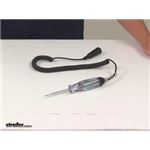























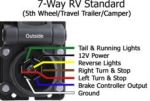



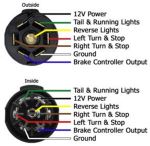
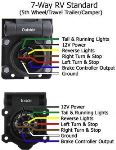
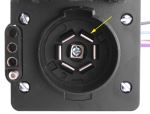
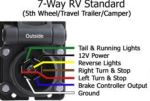


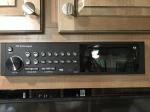

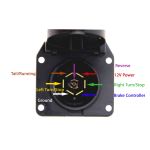
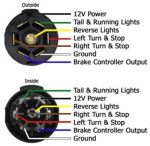
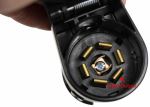
Paul P.
6/14/2021
Just fine. Thank you.